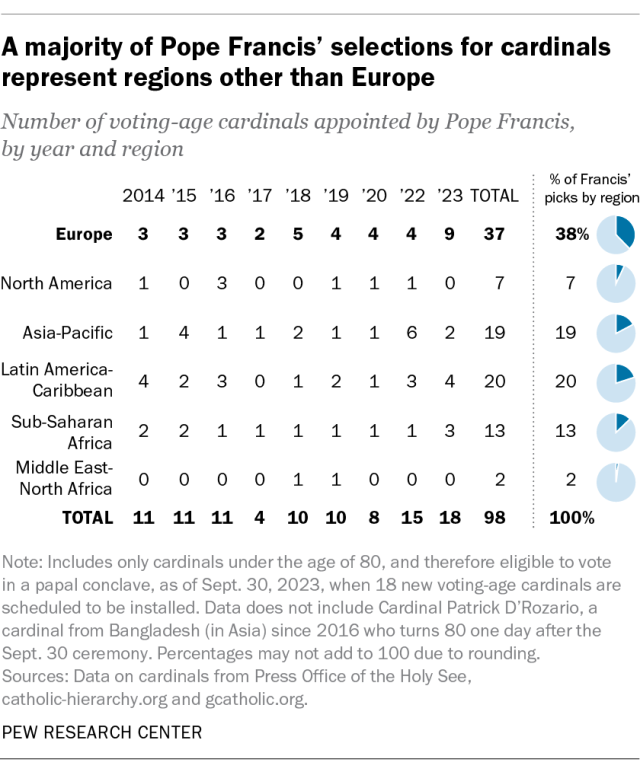Unless his reign is short, a pope usually appoints a majority of the men who will vote for his successor after he dies (or resigns).
But Pope Francis’ picks for the College of Cardinals since his election in 2013 have also served another purpose.
Over time, they have tilted the leadership structure of the Roman Catholic Church away from its historic European base and toward countries in Africa, Asia and Latin America.
In late September, 18 new voting cardinals will be installed at a ceremony in Vatican City.
At that point, there will be 136 cardinals who are under 80 years old and thus eligible to vote in the next papal election.
Here’s how the regional breakdown of all the voting cardinals will look after the next installment ceremony, compared with when Francis became pope a decade ago:
- The Asia-Pacific region will account for 18% of voting-age cardinals, up from 9% in 2013.
- The Latin American-Caribbean region will have 18%, up from 16% in 2013.
- Sub-Saharan Africa will account for 13% of cardinals, up from 9% in 2013.
- Europe will have 39%, down from 52% in 2013.
- North America will account for 10%, down from 12% in 2013.
- The Middle East-North Africa region will have 1%, down from 2% in 2013.
The figure of 136 voting cardinals excludes Patrick D’Rozario, a cardinal since 2016 whose 80th birthday is one day after the Sept. 30 ceremony.
A look at Francis’ picks over time
Francis, an Argentine who is the first pope from outside Europe since the eighth century, still has picked more cardinals from Europe than from any other region.

Of the 98 voting-age cardinals Francis has named during his papacy (including the 18 cardinals-elect), 38% are from Europe, 20% are from Latin America and the Caribbean, 19% are from the Asia-Pacific region, 13% are from sub-Saharan Africa, 7% are from North America and 2% are from the Middle East-North Africa region.
Altogether, the cardinals appointed by Francis will make up 72% of the 136 voting members of the College of Cardinals after the Sept. 30 ceremony. The remainder were appointed by Pope Benedict XVI and St. John Paul II.
Looking just at the new 18 voting-age cardinals who will be installed Sept. 30, here is the geographical breakdown:
- Nine will represent European countries, including France (2 cardinals-elect), Italy (2), Spain (2), Poland (1), Portugal (1) and Switzerland (1).
- Four will represent Latin America and Caribbean countries, including Argentina (2), Colombia (1) and Peru (1).
- Three will represent countries in sub-Saharan Africa: South Africa, South Sudan and Tanzania.
- Two will represent Asia-Pacific countries: China and Malaysia.
Cardinals and the world Catholic population
Vatican data from 2021 shows that 21% of the global Catholic population lives in Europe, so the continent remains heavily overrepresented among voting cardinals (39% of whom are from Europe).
By this measure, the most underrepresented region within the church’s leadership – even with Francis’ new picks – is the Latin America-Caribbean region, which was home to 41% of the worldwide Catholic population as of 2021 but has only 18% of the voting cardinals.
